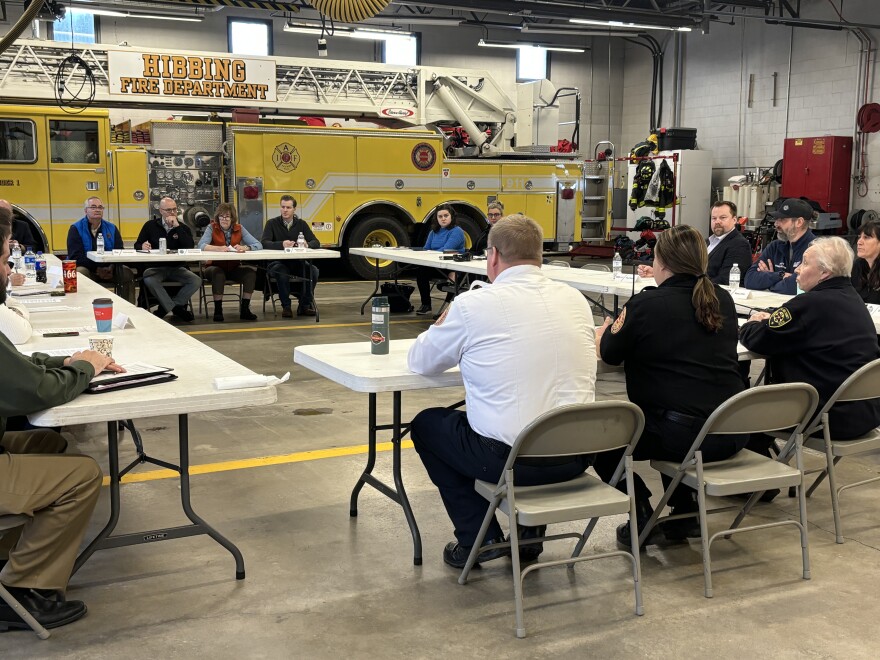HIBBING — Mounting stress on the rural EMS system caused by compounding issues is putting emergency responders in a difficult position. Calls and call times are up, staffing is a challenge, and the funding model has many services operating at a loss.
Minnesota elected officials heard all these issues and more at a Friday, Jan. 26, meeting at the Hibbing Fire Department. First responders from across northeastern Minnesota attended, and represented communities included Ely, Orr, Tower, Hoyt Lakes, Hibbing, Babbitt, Cook County and St. Louis County.
The meeting was organized by Sen. Tina Smith’s office. State Rep. Dave Lislegard of Aurora and state Sen. Grant Hauschild of Hermantown also attended. Both are on the Minnesota Legislature’s EMS Task Force, which must submit a report with recommendations by Aug. 15.

Complicated insurance billing is part of the issue.
“I’m really pretty pissed off almost every day at ... insurance companies,” Smith said. “It seems like they are increasingly in the business of denying care and making it harder for people to get what they need rather than easier.”
Medicare reimbursement is also a problem, and Smith is working to address part of it. Right now, when EMS provides care on scene without transporting the patient to the hospital, that service is not covered by Medicare. Lift assists, when someone falls and is unable to get up on their own but is otherwise uninjured, are a common example.
Sen. Smith is co-sponsoring a bill with Sens. Bernie Sanders, I-Vermont, and Peter Welch, D-Vermont, that would provide reimbursements for on-scene care. The bill was referred to the Senate Finance Committee in November 2023.
But the reimbursement issue is larger than that. Meeting attendees said most of their 9-1-1 callers are covered by Medicare. While ambulatory services are reimbursed, the rates haven’t kept up with costs.
Another problem is the large service areas and long distances to hospitals. Melanie Olmstead is the EMS director for Hoyt Lakes. She said because the Aurora hospital is in the Hoyt Lakes service area, ambulances are required to transfer those patients when necessary. In 2023, over half of the ambulance’s runs were transfers.
“Some days we’re taking five transfers out of there, some days we take zero,” Olmstead said. “But we can only afford to have one crew on call. So when that crew’s gone on a 3.5-hour transfer to Duluth, covering our 9-1-1s can get hairy.”
Without those transfers, the ambulance service probably would have closed years ago, she said. The next closest ambulance service is in Virginia, and Olmstead said that service already has more area than they can cover alone.
Staffing is also a problem. EMS directors can’t pay as much as their counterparts in larger cities and lose staff because of that. Most services in northeastern Minnesota are also volunteer-based or fully volunteer. Fewer volunteers or volunteers with busy schedules leave a few part-time employees responding to most calls.
Another challenge is the tax-funding structure. Many rural ambulance services are based in a city and funded by city resident’s taxes. People living in townships around that city are still served by the ambulance, but they don’t help fund it.

The wide variety and severity of issues with the rural EMS system means it’s time for an overhaul, leaders say. Lislegard said that’s part of what the state task force is looking at.
“People are looking for a stopgap in funding to help, but without structural change that’s just putting a Band-Aid on that’s going to be peeled off next year,” he said. “So we need to have a real conversation in Greater Minnesota: What does it look like long term so it’s sustainable?”
Paul Peltier, executive director of the Range Association of Municipalities and Schools, said he wants to make sure legislators remember where the problem is.
“This needs to be a rural solution for a rural fit. The problem is in rural Minnesota,” he said. “It is an acute, specialized problem that needs acute, specialized tactics and solutions to it, because our net tax capacity can’t keep up with the seven-county metro area.”







